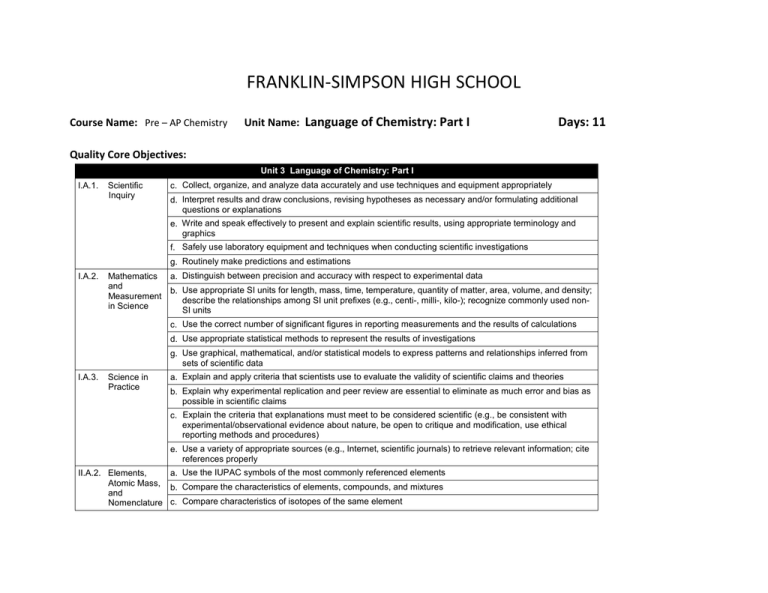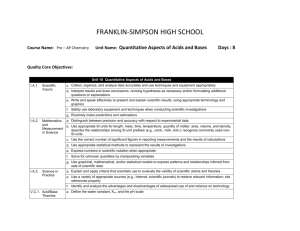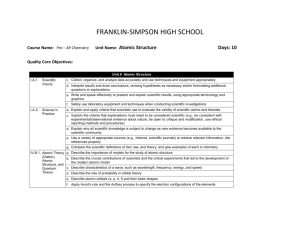Language of Chemistry, part I
advertisement

FRANKLIN-SIMPSON HIGH SCHOOL Course Name: Pre – AP Chemistry Unit Name: Language of Chemistry: Part I Days: 11 Quality Core Objectives: Unit 3 Language of Chemistry: Part I I.A.1. Scientific Inquiry c. Collect, organize, and analyze data accurately and use techniques and equipment appropriately d. Interpret results and draw conclusions, revising hypotheses as necessary and/or formulating additional questions or explanations e. Write and speak effectively to present and explain scientific results, using appropriate terminology and graphics f. Safely use laboratory equipment and techniques when conducting scientific investigations g. Routinely make predictions and estimations I.A.2. Mathematics a. Distinguish between precision and accuracy with respect to experimental data and b. Use appropriate SI units for length, mass, time, temperature, quantity of matter, area, volume, and density; Measurement describe the relationships among SI unit prefixes (e.g., centi-, milli-, kilo-); recognize commonly used nonin Science SI units c. Use the correct number of significant figures in reporting measurements and the results of calculations d. Use appropriate statistical methods to represent the results of investigations g. Use graphical, mathematical, and/or statistical models to express patterns and relationships inferred from sets of scientific data I.A.3. Science in Practice a. Explain and apply criteria that scientists use to evaluate the validity of scientific claims and theories b. Explain why experimental replication and peer review are essential to eliminate as much error and bias as possible in scientific claims c. Explain the criteria that explanations must meet to be considered scientific (e.g., be consistent with experimental/observational evidence about nature, be open to critique and modification, use ethical reporting methods and procedures) e. Use a variety of appropriate sources (e.g., Internet, scientific journals) to retrieve relevant information; cite references properly II.A.2. Elements, a. Use the IUPAC symbols of the most commonly referenced elements Atomic Mass, b. Compare the characteristics of elements, compounds, and mixtures and Nomenclature c. Compare characteristics of isotopes of the same element III.A.1. Empirical Formulas, Molecular Formulas, and Percentage Composition a. Distinguish between chemical symbols, empirical formulas, molecular formulas, and structural formulas b. Interpret the information conveyed by chemical formulas for numbers of atoms of each element represented c. Use the names, formulas, and charges of commonly referenced polyatomic ions d. Provide the interconversion of molecular formulas, structural formulas, and names, including common binary and ternary acids e. Calculate the percent composition of a substance, given its formula or masses of each component element in a sample g. Determine percent composition experimentally and derive empirical formulas from the data (e.g., for hydrates) IV.B.2. Periodic Table c. Use the periodic table to determine the atomic number; atomic mass; mass number; and number of protons, electrons, and neutrons in isotopes of elements and Periodicity d. Calculate the weighted average atomic mass of an element from isotopic abundance, given the atomic mass of each contributor Purpose of the Unit: The purpose of this unit is to familiarize students with some of the basics of the language scientists use that is specific to chemistry. Students will learn the names and symbols of the commonly used elements, polyatomic ions, and acids. Students will also learn about the different types of formulas used to represent compounds and structures of those compounds. Students will learn how to use to information on the periodic table to determine the number of protons, neutrons and electrons in different isotopes of elements as well as find the average atomic mass. Finally students will determine the empirical formulas of hydrates experimentally. Prerequisites: Students should be able to: Use the symbols and names for elements 1-20 Calculate protons, neutrons, electrons, atomic mass, and atomic number for an element Calculate percentages Compare characteristics of isotopes Distinguish between elements, compounds and mixtures Daily Lesson Guide Day 1 2 3 4 Lesson Content and Objectives * Element names and symbols * Polyatomic ion names, symbols, and charges II.A.2.a III.A.1.c * Names of acids * Characteristics of isotopes * Inside the atom II.A.2.c III.A.1.d IV.B.2.c, d * Average atomic mass IV.B.2.d * Interpreting different types of formulas * Conversions between different types of formulas III.A.1.a, b, d Focus Questions Critical Thinking Engagement (High Yield / Literacy /LTF/etc.) * What names do * Summarizing and note taking * Pre test chemists give to * Working with others * ACT bell ringer different symbols * Novelty and variety * Self creation of and combination study aides of symbols? * Quizzes in future over names (formative) * How are acids * Summarizing and note taking * ACT bell ringer named? * Analysis/ application * Graphic organizer * How are on naming acids different atoms * Modeled notes alike/ different? * Practice together (formative) Assessment and/or Accommodations * Evaluate pre test and formative assessment Enrichment: Less guidance in note taking, more independence in practice, more challenging examples in formative * Why are masses on the periodic table decimals and not whole numbers? * What do the different types of formulas represent? * How are they alike/ different? * Evaluate formative assessment Enrichment: Less guidance in note taking, more independence in practice, more challenging examples in formative * Evaluate formative assessment Enrichment: Less guidance in note taking, more independence in practice, more challenging examples in formative * Summarizing and note taking * I Do – We Do – You Do * Ananlysis * Sumarizing and note taking * I Do – We Do – You Do * Similarities and differences * Application/ Analysis * ACT bell ringer * Modeled notes * Pracitice problems together (formative) * ACT bell ringer * Modeled notes with graphic organizer * Practice problems together (formative) * Evaluate formative assessment and graphic organizer Enrichment: Less guidance in note taking, more independence in practice, more challenging examples in formative 5 * Percent composition of compounds and hydrates III.A.1.e, g * How can you use the formula of a compound to determine the percent composition? * Summarizing and note taking * I Do – You Do – We Do * Application * ACT bell ringer *Modeled notes * Practice problems together (formative) * MSDS sheet on Epsom salt * Evaluate formative assessment and for understanding of MSDS sheet Enrichment: Less guidance in note taking, more independence in practice, more challenging examples in formative 6-7 * Extra practice with naming elements, compounds, acids, and polyatomic ions II.A.2.a III.A.1.c, d * What can I do to get better at naming elements, compounds, and ions? * Novelty and variety * Working with others * ACT bell ringer * Use flash cards, partners, clickers, etc to practice naming and writing 8-9 * Laboratory: Formula of a hydrate I.A.1.c, d, e, f, g I.A.2.a, b, c, d, g I.A.3.a, b, c, d, e II.A.2.a, b, c III.A.1.a, b, c, d, e, g IV.B.2.c, d * How can I use what I know to experimentally determine the formula of an unknown hydrate? * ACT bell ringer * Conduct lab according to procedures provided (summative) 10 * Review I.A.1.c, d, e, f, g I.A.2.a, b, c, d, g I.A.3.a, b, c, e II.A.2.a, b, c III.A.1.a, b, c, d, e, g IV.B.2.c, d * What can I do to be better prepared for the exam? * Synthesis * Application/ Analysis * Identifying similarities and differences * Learning with others * Authenticity * Novelty and Variety * Generating and testing hypotheses * Use clickers to test students’ knowledge and clarify and misconceptions before the exam with immediate feedback. * Evaluate progress with periodic quizzes (these will continue throughout the year) Enrichment: Less guidance in note taking, more independence in practice, more challenging examples in formative * Evaluate lab report Enrichment: Student development of lab procedures with less guidance * ACT bell ringer * Use clickers to review with exam like questions (summative) * Students participate in review Enrichment: Less time to solve problems and limited use of aides 11 * Exam I.A.1.c, d, e, f, g I.A.2.a, b, c, d, g I.A.3.a, b, c, e II.A.2.a, b, c III.A.1.a, b, c, d, e, g IV.B.2.c, d * Can I demonstrate my knowledge on the exam? * Evaluation * Analysis * Application * Synthesis * ACT bell ringer * Students take exam (summative) * Evaluate exam Enrichment: No use of supports with exemption of periodic table, periodic table only has element symbols, not names



